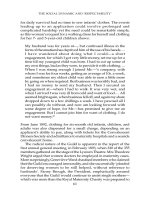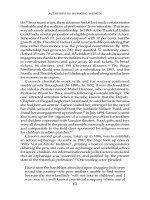ACTRESSES AS WORKING WOMEN 179
Bạn đang xem bản rút gọn của tài liệu. Xem và tải ngay bản đầy đủ của tài liệu tại đây (25.53 KB, 1 trang )
ACTRESSES AS WORKING WOMEN
between the stage and the auditorium, she fundamentally altered the
playhouse dynamics. Within the closed domestic scenic interior, Vestris
seemed to restore the ‘proper’ demarcation of public and private
realms, or at least achieved a partial illusion of having done so. She
also declared bankruptcy twice. Marie and Squire Bancroft completed
the boxed enclosure, locking it in a proscenium frame; in addition
they also eliminated farces and afterpieces from their bills, for without
a sexual ambiance the salacious interludes were pointless. When the
Bancrofts moved to the larger Haymarket they attacked the pit (a
prized vantage for connoisseurs of the female leg); they flourished,
but by 1880 there were other venues for anatomical display.
A reputation for excellent entertainments—on stage and in the
promenades—made the Alhambra the most popular tourist attraction
in mid-Victorian London. By the latter decades of the century, most
West End managers vehemently claimed to prohibit unauthorized
access backstage, implying that despite popular belief to the contrary
influential spectators could not approach actresses in the wings,
dressing rooms, or green rooms. If this prohibition was enforced, the
powerfully erogenous backstage would be neutralized, but evidence
relating to the Alhambra suggests that the practice endured. A letter
in the Greater London Record Office pseudonymously signed by a
‘Comic Singer with daughters in the profession’ inquired: ‘why are
the men well known for their seductive ways (the military officers as
a rule), encouraged and brought behind the scenes to solicit and entice
young girls to partake of supper, drives, &c. which means indirectly
for an immoral purpose[?]’ Distance loaned enchantment, but
proximity was better. The reason these men wanted to be backstage
was clearly related to the performance conventions. The ‘Comic Singer’
continues:
Who is answerable for the studied indecency of the costumes
exhibited in ‘Enchantment and Antiope’[?] In the latter ballet a
number of young girls appear in fleshing tights only to represent
the nude figure…a small gauze hung round the waist which
could be plainly seen through thus making things more
suggestive [than if there was] no extra covering round the loins[,]
abdomen[,] or posterior…the dresses were not worn to facilitate
art as the girls only moved to a slow movement.
The thing was only introduced to please the men frequenters
of the stalls, a class of men who use the place nightly and do
more mischief than the prostitutes.31
150









